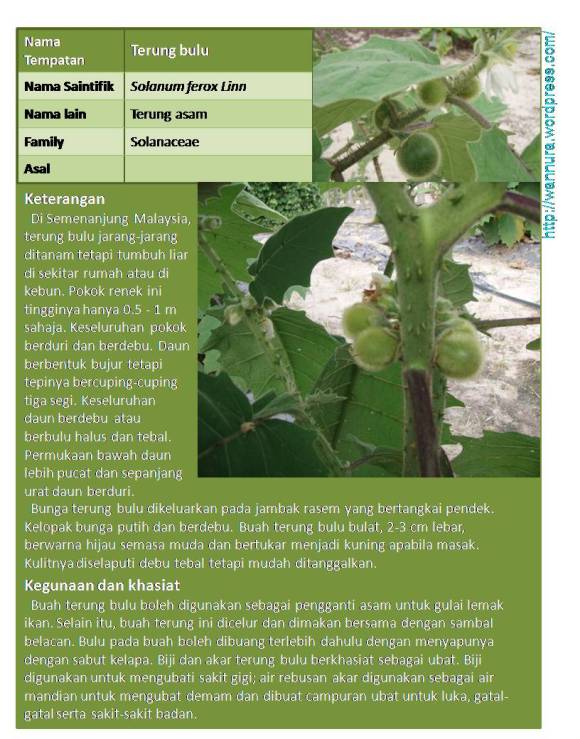Botanical Name : Solanum ferox Linn.
Family : Solanaceae
Other Scientific Names:Solanum lasiocarpum Dunal ,Solanum trongum Poiret ,Solanum hirsutum Roxb. ,Solanum zeylanicum Blanco
Local Names: Balbalusangi (Ilk.); basula (Ibn.); dabutung (Sul.); dagutung (Sul.); kamadaka (Iv.); tagatum (P. Bis.); talong-ayam (Bik.); talong-gubat (Tag.); talong-talong (Tag.); tarambola (Tag.); tarong-tarong (S. L. Bis.); tarambulo (Tag.); tagutong (Bis.).
Habitat :Tarambulo is found throughout the Philippines in waste places, old clearings, etc., at low and medium altitudes, ascending to 2,000 meters. It also occurs in India to southern China and Malaya.
Description:
This weed is a small, suberect, prickly, hairy herb 0.5 to 1.5 meters in height the leaves are ovate, 15 to 20 centimeters long, 12 to 23 centimeters wide, lobed at the margins, and densely covered with stiff woolly hairs above and woolly hairs and prickly spines on the nerves beneath; the lobes are triangular, and 2.5 to 4 centimeters deep. The flowers are borne on lateral racemes. The calyx is shortly funnel-shaped, with ovate- triangular lobes. The corolla is densely woolly without white, oblong-lobed, and 2 to 2.5 centimeters in length. The fruit (berry) is yellow, rounded, 2.5 to 3.5 centimeters in diameter, densely covered with needlike hairs, and many-seeded.
click & see the pictures
Edible Uses:
*In India, Thaland and Malaysia, fruit widely used as a sour-relish in curries.
*In Thailand, a special kind of sauce called nam prek is made with the fruit.
Medicinal Uses:
Folkloric
*Leaves used as poultices for swellings.
*Decoction of roots used for body pains and discomfort after meals.
*Decoction used for syphilis.
*Roots used externally for baths for fevers and as poultice for itches, cuts, wounds and bruises.
*Seeds used for toothaches – burned and the fumes inhaled.
*In Bangladesh, used for coughs, asthma, fever, vomiting, sore throat and gonorrhea.
*In India, used for female sex disorders.
Studies
• Seed Fat: Seeds yield a yellow colored oil, containing palmitic acid, stearic acid, oleic acid and linoleic acid.
Disclaimer:
The information presented herein is intended for educational purposes only. Individual results may vary, and before using any supplements, it is always advisable to consult with your own health care provider.
Resources:
http://www.stuartxchange.com/Tarambulo.html



